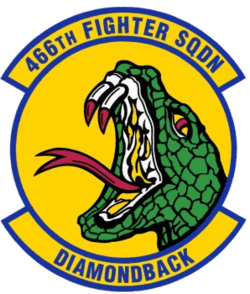466th Fighter Squadron
| 466th Fighter Squadron | |
|---|---|
|
Official crest of the 466th Fighter Squadron | |
| Active |
5 October 1944–25 November 1945 19 June 1952–11 May 1956 23 June 1972 – 1 February 1992 |
| Country | United States |
| Branch | United States Air Force |
| Part of |
Air Force Reserve Command Tenth Air Force 419th Fighter Wing 419th Operations Group |
| Garrison/HQ | Hill Air Force Base |
| Nickname(s) | Diamondback |
| F-16 Fighting Falcon | see "Aerospace vehicles" section below |
| Decorations | see "Lineage and honors" section below |

The 466th Fighter Squadron (466 FS) is the 419th Fighter Wing's designated flying squadron. They are located at Hill Air Force Base, Utah.
Overview
The 419th uses 15 F-16C/D model aircraft, which are light, air-to-air daytime fighters. The 466th Fighter Squadron first saw action in 1998, participating for the first time in the exercise Cape Tiger. This is a drill which puts reserve pilots shoulder to shoulder with members of the Thailand and Singapore Air Forces. Later that year, the 466th was deployed to Kuwait in time for Operation Southern Watch. The 466th was part of a unit attempting to hold off Iraqi movements toward Kuwaiti and Saudi Arabia.
History
Formed in late 1944 under Second Air Force as one of the last P-47 Thunderbolt Fighter Squadrons, programmed for deployment to Western Pacific theater with long-range P-47N for B-29 Superfortress escort missions. Arrived in Hawaii in early 1945, assigned to Seventh Air Force. Lack of a serious fighter defense over Japan at high altitudes and reprogramming of B-29 raids over Japan to night low-level fast attacks led to reassignment as a replacement training unit based in Hawaii; also performed air defense of the islands until inactivation in November 1945.
Reactivated as Strategic Air Command fighter-escort squadron for B-50 Superfortress and B-36 Peacemaker bombers. Performed fighter-escort training throughout the 1950s, inactivated in 1956 with the phaseout of the escort mission and retirement of the B-36.
Transferred to Tactical Air Command but not activated until 1972 as an F-105 Thunderchief squadron, being equipped with aircraft returned from inactivated Vietnam War squadrons to train other tactical fighter squadrons in Wild Weasel SAM suppression tactics. Since 1984 has trained to fly interdiction, close air support, and counter-air missions. Deployed periodically for contingency operations, or for training exercises with other units.
Lineage
- Constituted 466th Fighter Squadron on 5 October 1944
- Activated on 12 October 1944.
- Inactivated on 25 November 1945
- Redesignated 466th Fighter-Escort Squadron on 19 June 1952.
- Activated on 1 July 1952
- Redesignated 466th Strategic Fighter Squadron on 20 January 1953
- Inactivated on 11 May 1956
- Redesignated 466 Tactical Fighter Squadron on 23 June 1972
- Activated in the Reserve on 1 January 1973
- Redesignated 466 Fighter Squadron on 1 February 1992.
Assignments
- 508th Fighter Group, 12 October 1944 – 25 November 1945
- 508th Fighter-Escort (later Strategic Fighter) Wing, 1 July 1952 – 11 May 1956 (not operational, 1 July–September 1952)
- 508th Tactical Fighter Group, 1 January 1973
- 301st Tactical Fighter Wing, 25 March 1973
- 508th Tactical Fighter Group, 17 October 1975
- 419 Tactical Fighter (later, 419 Fighter) Wing, 1 October 1982
- 419th Operations Group, 1 August 1992–present
Stations
|
|
Aircraft
- P-47 Thunderbolt, 1944–1945
- F-84 Thunderjet, 1952–1956
- F-105 Thunderchief, 1973–1984
- T-33 Shooting Star, 1973–1980
- F-16 Falcon, 1984-present
References
![]() This article incorporates public domain material from the Air Force Historical Research Agency website http://www.afhra.af.mil/.
This article incorporates public domain material from the Air Force Historical Research Agency website http://www.afhra.af.mil/.
- Maurer, Maurer, ed. (1982) [1969]. Combat Squadrons of the Air Force, World War II (PDF) (reprint ed.). Washington, DC: Office of Air Force History. ISBN 0-405-12194-6. LCCN 70605402. OCLC 72556.
- 419 Fighter Wing factsheet
- Air Force Historical Research Agency: 466th Fighter Squadron
External links
- 466th Fighter Squadron info at global security.org
